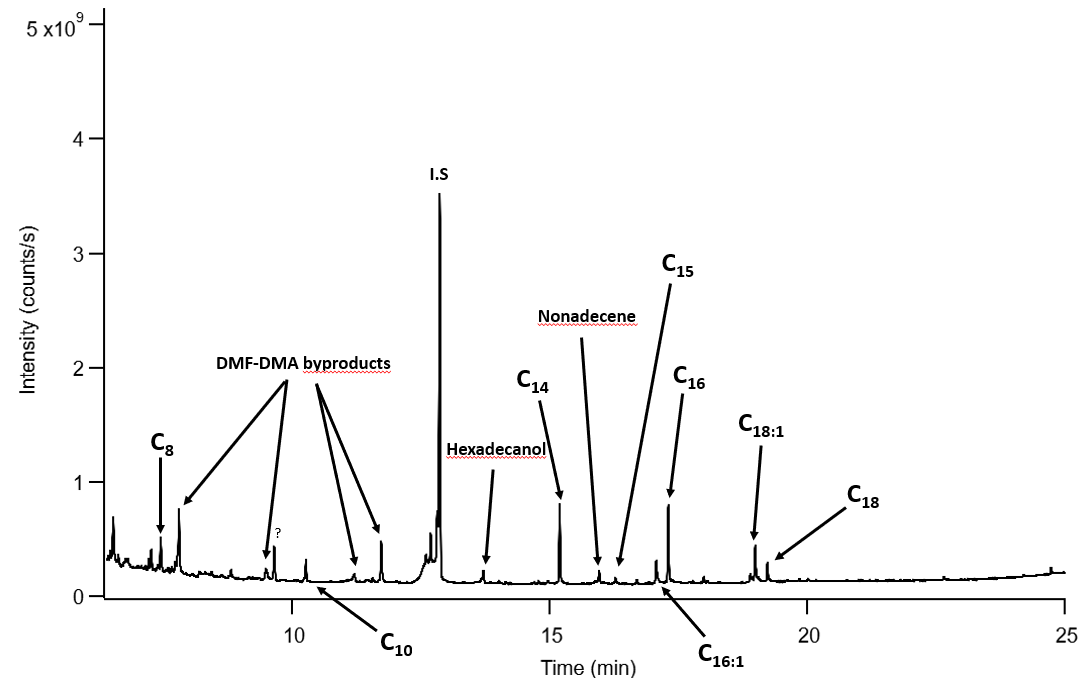Intro
Kerogen is insoluble, macromolecular organic matter in sedimentary rocks. Kerogen is highly abundant on Earth, making this subsurface carbon reservoir larger than any single surface carbon reservoir. Based on the origin of the organic matter, four types of kerogens are distinguished, with each their own chemical composition (Fig. 1). Type 1 is derived from fresh water algae, type 2 from marine algae, type 3 from terrestrial vascular plants, and type 4 is partially decomposed organic matter. Next to the abundance of kerogens on Earth, kerogens also comprise 70% of the organic material in carbonaceous chondrites (Sephton, 2002), and similar macromolecular organics have been discovered on the surface of Mars (Eigenbrode et al., 2018). As kerogens consist of large, insoluble, non-hydrolysable complexes (>1kDa), they are difficult for many microorganisms to access as an energy or carbon source (Vandenbroucke, 2003; Petsch et al., 2001). On the contrary, macromolecular organic material had been shown to be inhibitory to biofilms through occlusion of the biofilm surface (Freeman and Lock, 1992).
There is little understanding in the interaction of microorganisms with macromolecular, kerogenous material. This understanding is important as kerogenous material is a large carbon reservoir on Earth, and microbial degradation could impact the global carbon cycle with influences for climate change. Further, as kerogenous material is highly abundant in carbonaceous chondrites, and macromolecular material has been found on the surface of Mars, potential microbial usage of this material could have astrobiological implications. A proxy for extraterrestrial macromolecular, kerogenous material is kerogen embedded in rocks on Earth. In this research, we investigated the influence of each of the four kerogen types in rocks on the growth of an anaerobic microbial community.
Methods
An anaerobic microbial community capable of growth with a carbonaceous chondrite as the sole carbon and energy source as described in Waajen et al. (2022) was used. This community was grown for 11 days in microcosms containing liquid M9 medium with acetate and powdered rocks. Four types of rocks were tested, either shale or coal, with each rock sample containing one of the four kerogen types. At the end of the growth period, the community composition was determined by 16S amplicon sequencing. We also investigated the production of CO2, CH4 and H2 in the microcosms.
Results and discussion
Kerogen type 1 and 2 enhanced microbial growth to some extent. The microbial community composition did not change in the presence of kerogen type 1, but did change significantly during growth on kerogen type 2. This indicates that the growth of only a subset of the microbial community was enhanced by the presence of kerogen type 2, while another part of the community was not. We are currently investigating the metabolisms present in these environments, which could give an indication as to which compounds in these rocks will have influenced the growth of the community.
Kerogen type 3 did not enhance microbial growth, which could be explained by the abundancy of phenols in this type of kerogen. Phenols can be inhibiting in higher concentrations (Van Schie and Young, 1998).
Since this community has already been shown to grow on carbonaceous chondrite, growth enhancement on kerogen type 4 was to be expected, since this type is the closest analogue to macromolecular organics in meteorites (Matthewman et al., 2013). However, the community changed significantly during the growth in the presence of kerogen type 4, indicating that there are still significant differences between these environments. Further, kerogen type 4 is considered the most inert type of kerogen, containing mainly consisting polycyclic aromatic hydrocarbons (PAHs). Small PAHs can be degraded by microorganisms (Bamforth and Singleton, 2005), but it remains unknown whether the larger PAHs that are found in space can be used by microorganisms.
In addition to kerogens, shales and coal contain a small fraction of soluble organic material that could have been used by the microorganisms. Other compounds in shales and coals, such as metals, could also have influenced microbial growth. Further investigation in the type of material accessed by the microorganisms is needed to understand whether inert material from this type of kerogen can be microbially degraded.
No biological H2, CO2 or CH4 production was observed, which could be caused by the absence of certain metabolisms, or the direct consumption of these gases by other microorganisms. Alternatively, the low concentration of microorganisms in the microcosms could also have resulted in the lack of an observable production of these gases. We are currently analysing microbial community composition to indicate the presence of metabolisms which could produce these gases.
The potential of kerogenous material enhancing microbial growth has implications for the potential of life on Mars and in the presence of meteorites. The enhancement would indicate that the presence of macromolecular organic material in these environments would increase the habitability of these environments. Additionally, the potential degradation of kerogens has implications for carbon cycling on Earth, with the potential of the degradation of a large carbon reservoir. The entry of this stored carbon to the carbon cycle would have a large impact on climate change and should be further investigated.

Figure 1: Chemical characteristics of the four kerogen types indicating the thermal maturation and products that can be given off for human oil and gas use. The hydrogen index is the H/C ratio, the oxygen index is the O/C ratio. Taken from McCarthy et al., 2011.
References
References
Bamforth et al., Journal of Chemical Technology & Biotechnology (2005).
Eigenbrode et al., Science (2018).
Freeman et al., Applied and Environmental Microbiology (1992).
Matthewman et al., Astrobiology (2013).
McCarthy et al., Oilfield Review (2011).
Petsch et al., Science (2001).
Sephton, Natural product reports (2002).
Vandenbroucke, Oil & gas science and technology (2003).
Van Schie et al., Applied and environmental microbiology (1998).
Waajen et al., Astrobiology (2022).


















